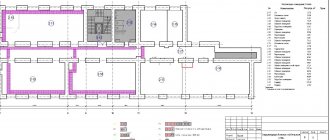The Supreme Court recalled the principle of the unity of fate of the site and the property located on it
On March 12, the Supreme Court issued Ruling No. 309-ES19-23230 on a dispute regarding the recognition of one of the co-owners of premises in a building as having a share in the common ownership of the land plot underneath it.
The courts did not agree on the claims
In November 2013, entrepreneur Vladimir Sholichev purchased from DK LLC premises in the administrative building on a site that at the time of the transaction belonged to the seller. In 2014, the company divided the plot into two, registering ownership of each of them. Subsequently, it sold, under a purchase and sale agreement, the non-residential premises in the building and the areas underneath it to Profnastil LLC.
Subsequently, the entrepreneur filed a claim with the Arbitration Court of the Kurgan Region against these companies for recognition of his ownership right to a share of a land plot in the amount of 279/1000 in common ownership, in proportion to the total area of the premises owned by him, as well as the right to a share in common ownership of common premises use in this building, registered under Profnastil LLC.
The arbitration court terminated the proceedings in relation to the plaintiff’s demand for recognition of his right to a share of the plot in accordance with clause 2 of part 1 of Art. 150 of the Arbitration Procedure Code of the Russian Federation, taking into account the decision of the Kurgan City Court in case No. 2-50/16, which entered into force, which rejected the claim of the plaintiff to the defendants for recognition of the right of common shared ownership of the disputed plot. The arbitration court also refused to satisfy the plaintiff’s request to combine cases No. A34-215/2019 and No. A34-3107/2019 into a single proceeding.
Thus, the court of first instance considered that in the case before it there was already a judicial act that had entered into force, adopted on a dispute about the same subject and on the same grounds. Consequently, the plaintiff has already exercised his right to judicial protection in relation to the right of shared ownership of the plot where the building with non-residential premises belonging to him is located.
The appeal overturned the decision of the first instance, returning the case for review. At the same time, she agreed with the conclusions of the lower court about the identity of the participants in the cases, but considered the requirements in the case under consideration to be independent and different from those that were considered in the framework of the civil dispute.
The appellate court also noted that the plaintiff stated new demands that are not identical to those considered by the court of general jurisdiction, and his demand for recognition of the right to a share in the common ownership of the plot is the main one. Accordingly, without its consideration, the remaining claims arising from the main one cannot be resolved on their merits. The appeal also considered that consolidation of the cases into one proceeding would help ensure procedural economy and achieve legal certainty on all interrelated claims of the plaintiff as quickly as possible. Thus, the court concluded that the first instance had no grounds for terminating the proceedings in accordance with paragraph 2 of Part 1 of Art. 150 APK.
Subsequently, the district court overturned the appeal ruling, upholding the first instance ruling. The cassation considered that the plaintiff stated a similar requirement in relation to the same land plot, as well as for recognition of ownership in proportion to the total area of the premises in the disputed building, therefore, indicating a specific proportion in this case does not change the subject of the demand.
Disagreeing with this decision, the entrepreneur appealed to the Supreme Court. In the cassation appeal, he asked to cancel the judicial acts of the first and cassation instances and to uphold the appeal decision.
The Supreme Court supported the arguments of the appellate court
Having studied the materials of case No. A34-215/2019, the Judicial Collegium for Economic Disputes of the Supreme Court recalled that the court terminates the proceedings in accordance with paragraph 2 of Part 1 of Art. 150 of the Arbitration Procedure Code, if it establishes the existence of an act of an arbitration court, a court of general jurisdiction or a competent court of a foreign state that has entered into force in a dispute between the same persons, on the same subject and on the same grounds, except in cases where the arbitration court has refused to recognize and enforcement of a foreign court decision.
The Supreme Court explained that in the case under consideration, the entrepreneur stated his demands for the first time; they were not the subject of consideration by another court, and therefore are independent. As the Court noted, from the operative part of the decision of the court of general jurisdiction it follows that the case was considered on the merits and the court refused to satisfy the following demands: to terminate the registered ownership of the defendants to the disputed plot; on the invalidation of contracts for the sale and purchase of plots concluded by the defendants; on recognition of the right of common shared ownership of all owners of premises in the building.
“At the same time, as the entrepreneur reasonably points out, the grounds for the emergence of his right to a share in the ownership of a land plot <...> by force of law from the moment of state registration of the transfer to him of ownership of the premises in the building in accordance with the provisions of Art. 131, paragraph 2 of Art. 223, paragraph 4 of Art. 244, paragraph 2 of Art. 552 of the Civil Code of the Russian Federation, to which he referred when considering this case, the court did not examine. The court of general jurisdiction examined the claims aimed at challenging the transfer of the right to a land plot to the Profnastil company in order to establish a regime of common shared ownership,” the definition notes.
Thus, the Supreme Court considered that the entrepreneur’s demand for recognition of his ownership of the share was stated for the first time and is not similar to the demand considered in another case. The Supreme Court added that the fact that the plaintiff acquired ownership of the premises in the building preceded the purchase and sale transactions of the disputed plots, which violates the principle of the unity of fate of the plot and the real estate located on it.
“At the same time, as the entrepreneur rightfully points out, no other method aimed at restoring his violated rights to the land plot is seen; the applicant, in accordance with the circumstances established in the case and the essence of the violation of his rights, chose the appropriate method of protecting them,” the Supreme Court noted.
As a result, the Supreme Court overturned the judicial acts of the first and cassation instances, leaving the appeal decision in force.
Experts commented on the findings of the Supreme Court
According to Takhmina Arabova, partner of Bartolius Law Firm, the Supreme Court consistently protects the principle of the unity of fate of the land plot and the building located on it, one of the manifestations of which is the right of common shared ownership of the plot belonging to the owners of the premises in this building.
“In this case, it is noteworthy that, in defending this principle, the Supreme Court is ready to take a broad look at the identity of claims and use the slightest difference in them, if this can help to connect one person’s title to land and ownership of a building (premises),” noted she is in the comment “AG”.
Senior lawyer, Real Estate practice. Earth. Construction” of the VEGAS LEX law firm, Marina Preobrazhenskaya believes that in the case under consideration, the highest court indirectly raised the question of whether the buyer of the premises in the building had a right of ownership to the land, since as part of the dispute the claim of the owner of the premises against the seller of real estate and the owner of the plot was considered, who was also the buyer of other premises in this building.
The expert explained that in judicial practice, disputes have repeatedly arisen about whether the acquisition of ownership rights to non-residential premises located in a building entails the emergence of ownership rights to a share of a land plot. Before March 1, 2015, she added, there was no unified approach to addressing this issue. Despite the absence in the law of direct regulation of the transfer of ownership of the plot to the buyer of premises in the building, based on the totality of legal norms (clause 2 of article 555 of the Civil Code of the Russian Federation, clause 4 of article 35 of the Land Code of the Russian Federation as amended, valid until March 1, 2015 .), the courts predominantly satisfied the claims of premises owners for recognition of ownership of a share in the right to a plot necessary for the use of the property.
This legal position of the courts, Marina Preobrazhenskaya believes, was formed largely thanks to the explanations of the Supreme Arbitration Court of the Russian Federation (see, for example, paragraph 17 of the Information Letter of the Supreme Arbitration Court of January 28, 2005 No. 90, paragraph 25 of the Resolution of the Plenum of the Supreme Arbitration Court of November 17, 2011 . No. 73), which partially addressed the issues of the unity of fate of land plots and the objects located on them in relation to premises. However, due to the absence of a direct instruction from the highest court to resolve this issue in favor of the owners of the premises, some courts disagreed with the opinion that the purchaser of the premises acquired the right of ownership to a share of the plot.
The expert added that from March 1, 2015, paragraph 4 of Art. 35 of the Land Code was supplemented with paragraph. 7, according to which the alienation by a participant in shared ownership of a share in the right to a building, structure or alienation by the owner of a part of a building, structure or premises belonging to him is carried out together with the alienation of a share in the right of ownership of the land plot where these objects are located. “Thus, transactions for the alienation of premises without alienation of a share in the ownership of the corresponding plot, concluded from the specified date, are contrary to the law. Moreover, the Supreme Court, in Ruling No. 49-KG18-26 dated August 14, 2021, indicated the transfer to the buyer of the premises of a share in the right to the plot on which this property is located, even if the premises were purchased before March 1, 2015. Despite this that the dispute was not resolved on the merits by the ruling in question, the Supreme Court made an important conclusion for the plaintiff about the violation of the principle of unity of the land plot and the real estate located on it (premises owned by the entrepreneur),” concluded Marina Preobrazhenskaya.
In her opinion, this circumstance, in conjunction with paragraph 4 of Art. 35 of the Land Code and examples from law enforcement practice will allow the plaintiff in the dispute under consideration to defend the right to a share of the site necessary for the operation of the premises of which he is the owner. “In order to protect the interests - first of all, of the buyers of premises - as well as to avoid disputes between the parties to transactions when selling premises in a building, it is advisable to determine the issue of transferring to the buyer a specific share in the right to a land plot directly in the real estate purchase and sale agreement,” - The lawyer recommended in conclusion.
Indentations depending on the type and number of storeys of the building
The location of a residential building and its distance from the neighboring plot, outbuildings or buildings is regulated by SNiP 2.07.01-89. In Moscow there are separate design standards, MGSN 1.01-99, which are also used in the Moscow region. The government of St. Petersburg also adopted separate resolutions in order to preserve the historical features and accepted development trends of the unique city.
Indentation standards according to SNiP and law
The primary requirements for the relative location of a residential building and a building of the same type, children's and medical institutions, public buildings and enterprises is maintaining the distance required for the following:
- ventilation and lighting, when living or carrying out core activities;
- fire safety standards are given in the Appendix of this mandatory document;
- household gaps amounting to 15 m for low-rise buildings and 20 m starting from 4 floors; they are sometimes reduced if other requirements are met;
- the distance to the boundaries of the site from outbuildings is at least a meter, but this distance is minimized by mutually blocking buildings of the same type;
- if we are talking about the remoteness of the side of the street, then in this case the distance from the red line is determined according to the construction plans approved by the local territorial community and RS authorities.
Norms and rules for individual housing construction and SNT
To accurately determine the distance, it is necessary to study the master plan.
The figure depends on the category of the street, the presence of utilities (gas pipes, power lines, ground heating, operating conditions of the facility and its safety). The distance from the red line can be from 3 to 10 meters, and this will comply with the law.
Minimum setbacks from the boundaries of the land plot
The distance from the boundary when building a house depends on the material of its construction. The minimum setback from the boundaries of a land plot on the territory of individual housing construction and SNT is equal, according to SNiP standards, to 3 meters. However, for buildings made of non-combustible building materials in adjacent areas, erected with appropriate floors, it is necessary to comply with fire safety standards - a mandatory 6 meters between them.
Distances to the road and between houses according to SNiP
The minimum distance between houses made of the same materials, but with wooden floors, should be at least 8 meters. Houses and buildings made from fire-hazardous building materials are located at a distance of 12 m.









